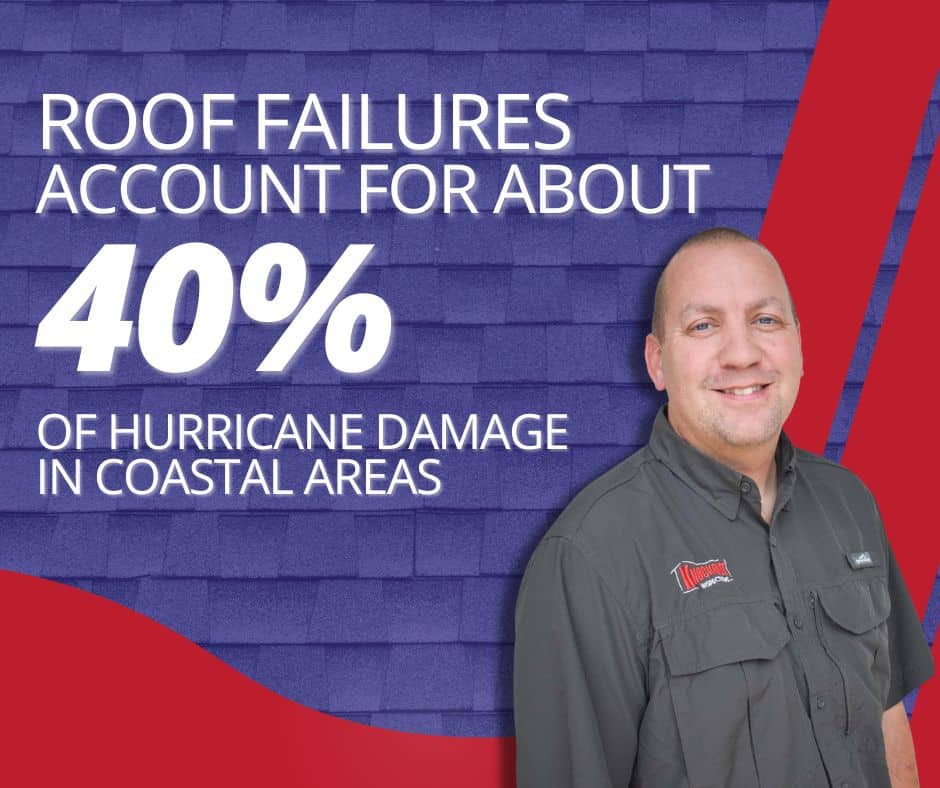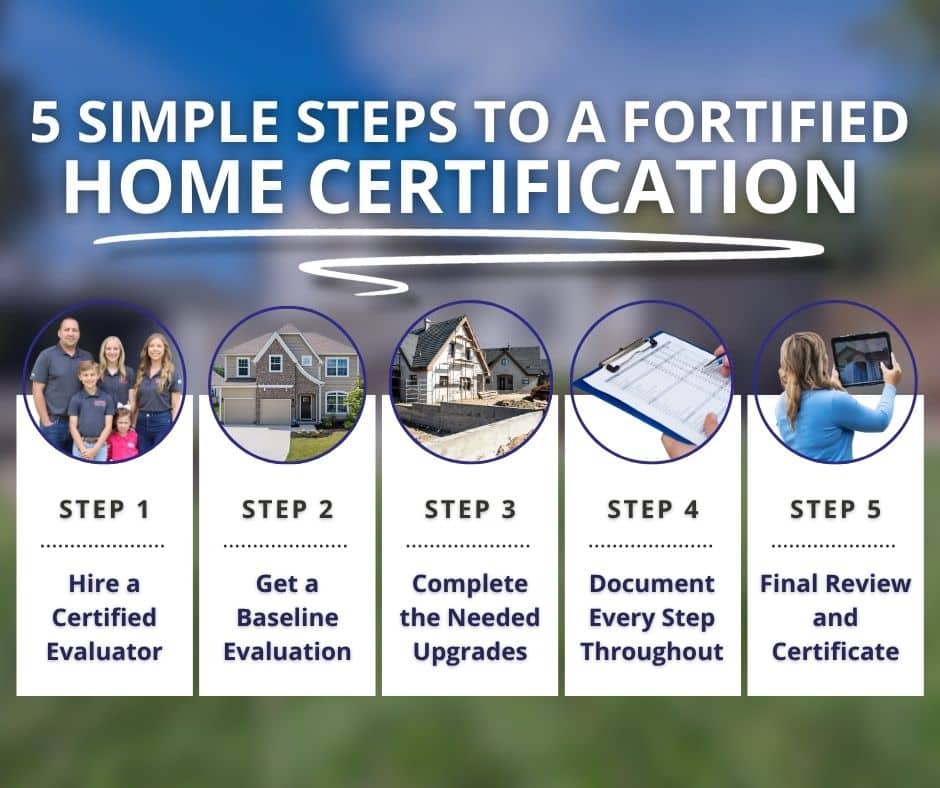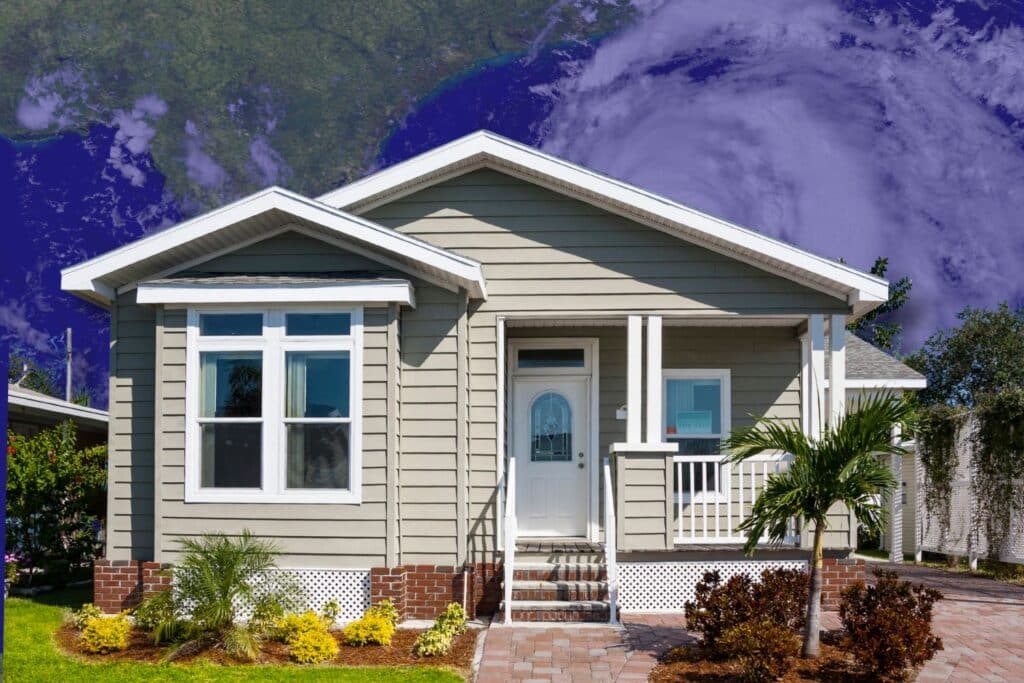This guide explains the main structural features that make homes hurricane-resistant, what inspectors look for, and how you can strengthen your property before the next storm.
When hurricane season arrives, every homeowner along the Gulf Coast wonders whether their house can truly withstand the storm. Strong winds, flying debris, and heavy rain can test every part of a structure.
A hurricane-resistant home is not just built to survive but designed to resist damage through smart engineering and proven construction techniques.
At Knockout Inspections, we specialize in evaluating those systems through FORTIFIED Roof™ and FORTIFIED Home™ inspections, helping homeowners in Alabama, Mississippi, Florida, and Louisiana understand how well their property stands up to hurricane conditions.
What Makes Homes Hurricane-Resistant?
Hurricane-resistant homes perform well under high winds because their parts work together to form a continuous load path. This means that the roof, walls, and foundation are all securely connected, transferring wind forces safely to the ground.
According to the Insurance Institute for Business & Home Safety (IBHS), homes built or upgraded to FORTIFIED standards can reduce storm-related damage by up to 70% compared to traditional construction.
The key is not one product or upgrade but a full system of strength and moisture protection that includes:
- A secure, well-sealed roof
- Strong wall framing and connections
- Reinforced openings like windows and doors
- Proper elevation and foundation design
1. Roof Systems that Defend Against Wind and Rain
The roof is a home’s first line of defense during a hurricane or other harsh weather, and naturally, the first point when designing hurricane-resistant homes. Once wind gets under shingles or rain seeps into the deck, damage spreads quickly.
A hurricane-resistant roof includes several structural details that inspectors look for:
| Feature | Function | Why It Matters |
| Roof Deck Attachment | Uses ring-shank nails or screws to secure decking to trusses | Prevents roof panels from lifting in strong winds |
| Sealed Roof Deck | Adds a waterproof layer beneath shingles or metal panels | Stops rain from entering if the outer layer is damaged |
| Edge Metal and Drip Edge | Reinforces the perimeter of the roof | Keeps wind from prying up the edge materials |
| Hurricane Straps or Clips | Ties rafters and trusses to wall plates | Keeps the roof connected to the home under stress |
| Proper Roof Geometry | Simple hip or gable shapes reduce wind turbulence | Creates smoother airflow and less uplift pressure |
The FORTIFIED Roof™ program focuses on these features specifically, requiring proper nail spacing, sealed decking, and protected edges. Knockout Inspections evaluates all these elements during inspections and verifies whether a home qualifies for FORTIFIED Roof certification.
The National Oceanic and Atmospheric Administration (NOAA) reports that roof failures account for about 40% of total hurricane damage in coastal areas, making this system the single most important part of a storm-ready home.

2. Strong Wall Construction and Load Connections
Walls hold the structure together and transfer loads from the roof down to the foundation. If that connection is weak, wind can separate entire sections of the home.
Important wall-related features include:
- Continuous Load Path: Every part of the house is connected by metal tie-downs, bolts, or straps that transfer wind forces downward.
- Reinforced Masonry or Concrete Block Walls: Often used in coastal regions to resist impact and lateral pressure.
- Shear Bracing: Plywood or OSB panels that provide stability and prevent twisting.
- Proper Wall-to-Roof Connections: Metal anchors that keep the top of the wall tied to the truss system.
Knockout Inspections reviews how well these connections perform and whether the wall design provides a complete path of strength. This is one of the main differences between standard homes and FORTIFIED Home™ properties.
3. Windows and Doors That Resist Impact
When high-speed winds breach an opening, internal air pressure can build rapidly, leading to roof lift or wall collapse. Preventing that pressure is essential for keeping the structure intact.
Hurricane-resistant openings include:
- Impact-Rated Windows: Built with laminated glass that resists debris penetration.
- Wind-Rated Doors: Heavy-duty hinges and strike plates that withstand suction pressure.
- Garage Door Reinforcements: Metal bracing or upgraded tracks that prevent failure in large openings.
- Permanent or Removable Storm Shutters: Provide extra protection for vulnerable windows.
According to FEMA, a single failed window or door can cause structural failure within minutes once wind enters the home. A professional should check whether these openings meet local design pressures and if they have the proper certifications for coastal zones.
4. Reliable Foundations and Proper Elevation
The strength of the foundation determines how well the rest of the structure performs. In flood-prone coastal zones, homes must be elevated to prevent both erosion and hydrostatic pressure damage.
Best practices for hurricane-resistant foundations:
- Raised Slab or Pier Construction: Keeps the living space above expected flood levels.
- Anchored Connections: Bolts or straps secure framing to the foundation.
- Well-Compacted Soil or Pilings: Provides stable support and reduces shifting.
- Effective Drainage Design: Directs water away from the foundation to prevent pooling.
Properly elevated foundations can reduce flood-related losses by more than 80%. During Knockout’s inspections, we check for visible foundation cracks, anchoring points, and proper elevation height based on local flood maps.
5. Roofing and Siding Materials Make a Difference
The right building materials can determine how long a structure lasts under high winds. In Gulf Coast regions, Knockout Inspections frequently sees two roofing materials that perform best against hurricane conditions: asphalt shingles and metal panels.
Best materials for coastal homes:
- Architectural Asphalt Shingles: Rated for high wind uplift, often up to 130 mph or more.
- Metal Roofing: Exceptionally durable, corrosion-resistant, and lightweight.
- Fiber-Cement Siding: Resists moisture, pests, and impact.
- Vinyl Siding with Proper Fasteners: Performs well if installed with correct spacing and backing.
While metal roofs often offer the best wind resistance, asphalt remains a strong, affordable option if installed to FORTIFIED Roof standards. Knockout Inspections checks nail patterns, flashing, and sealing to confirm compliance.
6. Secondary Barriers and Drainage Systems
Preventing water entry is as important as stopping wind. Water damage can compromise framing and insulation even in homes that survive the storm structurally.
Key features to prevent moisture damage include:
- Roof underlayment or self-sealing membranes
- Proper flashing around chimneys, valleys, and vents
- Gutters and downspouts that direct water six feet away from the home
- Graded soil sloping away from the foundation
- Working sump pumps or French drains in low areas
The EPA notes that homes with proper drainage experience up to 60% fewer structural moisture issues over time. Inspectors always review these systems because drainage failures are one of the most common causes of hidden foundation stress.
7. FORTIFIED™ Home Programs
The FORTIFIED Home™ Program, developed by IBHS, is the leading national standard for hurricane-resistant homes. It includes three protection levels that can apply to new or existing homes.
| Level | Focus | Typical Improvements |
| FORTIFIED Roof™ | Roof decking, sealing, and edge reinforcement | Ring-shank nails, sealed roof deck, drip edges |
| FORTIFIED Silver™ | Adds wall and opening protection | Continuous load paths, upgraded fasteners |
| FORTIFIED Gold™ | Full structural connection from roof to foundation | Advanced tie-downs, reinforced walls, verified load paths |
Knockout Inspections performs full evaluations for homeowners seeking FORTIFIED Roof or FORTIFIED Home verification. Our reports follow IBHS requirements and help homeowners qualify for insurance discounts or rebuild grants in participating states.
In Alabama, Mississippi, and Louisiana, state-level incentives may apply for verified FORTIFIED Roof upgrades, reducing long-term insurance premiums and increasing property value.
How Our Team Evaluates Hurricane Resistance
For our team, every inspection starts with the same goal: to help homeowners understand how their home performs under extreme conditions and where improvements could make the biggest difference.

Our process includes:
- Reviewing construction materials, previous inspection reports, and any prior wind mitigation documentation.
- Inspecting the roof system, fasteners, and sealing details.
- Checking connections between the roof, walls, and foundation.
- Measuring elevation and reviewing flood zone data.
- Assessing window and door ratings, garage door strength, and shutter installation.
- Documenting findings with clear photos and a detailed written report.
Each report outlines what’s compliant, what’s at risk, and which upgrades could bring the home closer to FORTIFIED certification or improved hurricane resistance.
When to Schedule a Home Inspection or FORTIFIED Evaluation
Even the strongest homes need periodic inspections to stay storm-ready. Over time, fasteners can corrode, sealants can weaken, and changes to landscaping or drainage can alter how water moves around the property. These small issues can grow into major problems during hurricane season if left unchecked.
Regular home inspections and FORTIFIED evaluations help homeowners:
- Catch early signs of wear, corrosion, or water intrusion
- Confirm that previous repairs or upgrades were done correctly
- Keep documentation for insurance or FORTIFIED certification
- Plan targeted, cost-effective improvements before storm season
The NOAA National Weather Service reports that about one in four hurricane-related home losses results from preventable maintenance issues. A professional inspection before each season can save thousands in potential damage.
If your home was built before newer hurricane codes or you are unsure of its protection level, schedule a home inspection or FORTIFIED evaluation with Knockout Inspections.
Related Questions
Can a Standard Home Inspection Check for Hurricane Readiness?
A standard inspection reviews general structure and safety, but it does not evaluate to FORTIFIED standards. If you live in a hurricane-prone region, adding a FORTIFIED Roof or FORTIFIED Home evaluation ensures your property meets proven hurricane-resistance benchmarks.
Can My Older Home Qualify for FORTIFIED Certification?
Yes. Many older homes can achieve FORTIFIED Roof or FORTIFIED Home certification through upgrades such as improved decking attachment and edge reinforcement.
Can Knockout Inspections Help With Documentation for Insurance Purposes?
Yes. After your FORTIFIED or wind mitigation inspection, we provide detailed reports that meet insurer and IBHS requirements, making it easier to apply for credits or reduced premiums.
Conclusion
Building or owning hurricane-resistant homes means more than just hoping for the best during storm season. It means understanding how every part of your structure works together to handle the pressure.
At Knockout Inspections, we help homeowners identify strengths, correct weaknesses, and verify FORTIFIED features that make a measurable difference in safety.
If you want confidence before the next storm hits, schedule your inspection today and see how Knockout Inspections helps you protect your home from the roof down.

